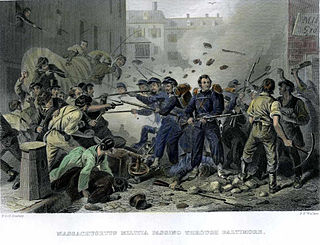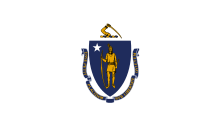
William Francis Bartlett was a general in the Union Army during the American Civil War and, later, an executive in the iron industry.

The 1st Massachusetts Volunteer Heavy Artillery Regiment was a unit that served in the Union Army during the American Civil War. It was originally raised as the 14th Massachusetts Volunteer Infantry Regiment.

The 29th Regiment Massachusetts Volunteer Infantry was an infantry regiment in the Union army of the United States during the American Civil War. The regiment was organized in December 1861 when three new companies were attached to a battalion of seven Massachusetts companies that had been in active service since May 1861. These seven companies had been recruited to fill out the 3rd Massachusetts and 4th Massachusetts regiments and had signed on for three years of service. When the 3rd and 4th Massachusetts were mustered out in July 1861, the seven companies that had signed on for three years were grouped together to form a battalion known as the Massachusetts Battalion. Finally, in December 1861, three more companies were added to their roster to form a full regiment and the unit was designated the 29th Massachusetts.

The 3rd Massachusetts Battery, was an artillery battery that served in the Union Army during the American Civil War.
The 40th Regiment, Massachusetts Volunteer Infantry Regiment was a three-year infantry regiment of the Union Army that served in the Department of Virginia and North Carolina, the Army of the Potomac, and the Department of the South during the American Civil War.
The 9th Massachusetts Battery was a field artillery battery that served in the Union Army during the American Civil War.
The 3rd Massachusetts Volunteer Cavalry Regiment was a cavalry regiment that served in the Union Army during the American Civil War. It was organized by consolidating the 41st Massachusetts Mounted Infantry and the 2nd Battalion Massachusetts Cavalry on June 17, 1863. The regiment served with the XIX Corps, Army of the Gulf during the Red River Campaign in 1864. Its heaviest combat during this campaign took place during the Battle of Sabine Crossroads.

The 5th Regiment Massachusetts Volunteer Militia was a peacetime infantry regiment that was activated for federal service in the Union army for three separate tours during the American Civil War. In the years immediately preceding the war and during its first term of service, the regiment consisted primarily of companies from Essex County as well as Boston and Charlestown.

The 6th Regiment Massachusetts Volunteer Militia was a peacetime infantry regiment that was activated for federal service in the Union army for three separate terms during the American Civil War (1861-1865). The regiment gained notoriety as the first unit in the Union Army to suffer fatal casualties in action during the Civil War in the Baltimore Riot and the first militia unit to arrive in Washington D.C., in response to President Abraham Lincoln's initial call for 75,000 troops. Private Luther C. Ladd of the 6th Massachusetts is often referred to as the first Union soldier killed in action during the war.

The 42nd Regiment Massachusetts Volunteer Infantry was a regiment of infantry that served two tours in the Union Army during the American Civil War. The unit was first formed in September 1862 in response to President Abraham Lincoln's call for 300,000 men to serve for nine months.

The 56th Regiment Massachusetts Volunteer Infantry was a regiment of infantry that served in the Union Army during the American Civil War. It was one of the four "Veteran Regiments" raised in the winter of 1863–64. Recruits of these regiments were required to have served at least nine months in a prior unit. The regiment was attached to the IX Corps of the Army of the Potomac and took part in Lieutenant General Ulysses S. Grant's Overland Campaign in the spring of 1864. They were in extremely heavy combat during the campaign, suffering great casualties during engagements which included the Battle of the Wilderness, Spotsylvania Courthouse, and the Battle of the Crater. They were involved in several assaults during the Siege of Petersburg in 1864 and participated in the spring 1865 battles which finally drove General Robert E. Lee's Confederate Army from their entrenchments in Petersburg, leading to the end of the war at Appomattox Courthouse.

The 1st Massachusetts Battery was a peacetime militia artillery battery that was activated for federal service in the Union army for two separate tours during the American Civil War. Prior to the war and during its first term of service, the unit was sometimes known as "Cook's Battery" after its commanding officer, Capt. Asa M. Cook. During its first term, the battery primarily served garrison duty in Baltimore, Maryland. Almost immediately after mustering out, the unit began preparing for a second term, this time volunteering to serve for three years. The battery was attached to the VI Corps of the Army of the Potomac during its second term and took part in some of the largest battles of the war including the Fredericksburg, Chancellorsville, Gettysburg, and Lieutenant General Ulysses S. Grant's Overland Campaign in the spring of 1864.

The 4th Massachusetts Battery was an artillery battery that served in the Union Army during the American Civil War. The unit was sometimes known as "Manning's Battery" after its commanding officer, Capt. Charles H. Manning. It was one of the Massachusetts regiments organized in response to President Abraham Lincoln's call on May 2, 1861 for volunteer troops to serve a term of three-years. The core of the unit was a peace-time militia company known as the Salem Light Artillery. The battery trained at Camp Chase in Lowell, Massachusetts. It was assigned to the Department of the Gulf under Major General Benjamin F. Butler and departed Boston by steamship on November 20.

The 5th Massachusetts Battery was an artillery battery that served in the Union army during the American Civil War. It was one of the Massachusetts regiments organized in response to President Abraham Lincoln's call on May 2, 1861 for volunteer troops to serve a term of three-years. The battery trained at Camp Shouler in Lynnfield, Massachusetts and Camp Massasoit in Readville, Massachusetts. It departed Boston by steamship on December 25, 1861.

The 6th Massachusetts Battery was an artillery battery that served in the Union Army during the American Civil War. The unit was one of the Massachusetts regiments organized in response to President Abraham Lincoln's call on May 2, 1861 for volunteer troops to serve a term of three-years. The battery trained at Camp Chase in Lowell, Massachusetts. It was assigned to the Department of the Gulf under Major General Benjamin F. Butler and departed Boston by steamship on February 8, 1862. At that time, the unit comprised 145 men armed with two rifled and four smoothbore six-pounder field guns.

The 11th Massachusetts Battery was an artillery battery that served in the Union Army during the American Civil War. It was formed in response to President Abraham Lincoln's August 1862 call for 300,000 men to serve for nine months. Several months after completing their first term of service, the battery was reorganized for a second term of three years. It was recruited by Captain Edward J. Jones of Boston and consisted almost entirely of men from that city. The battery served a largely uneventful first term as garrison troops mostly in Centreville, Virginia. During their second term they were involved in heavy combat being part of the Army of the Potomac during Lieutenant General Ulysses S. Grant's Overland Campaign.

The 12th Massachusetts Battery was an artillery battery that served in the Union Army during the American Civil War. The unit was organized at Camp Meigs near Boston during the fall of 1862. Its members were mustered in at various times over the fall and the officers mustered into federal service on December 8, 1862. It was assigned to the Department of the Gulf under Major General Nathaniel P. Banks and departed Massachusetts by steamship on January 3, 1863.

The 13th Massachusetts Battery was an artillery battery that served in the Union Army during the American Civil War. The unit was organized at Camp Meigs near Boston during the fall of 1862. Its members were mustered in at various times over the fall and the officers mustered into federal service on November 3, 1862. It was assigned to the Department of the Gulf commanded by Major General Nathaniel P. Banks and departed Massachusetts by steamship on January 20, 1863.

The 14th Massachusetts Battery was an artillery battery that served in the Union Army during the American Civil War. It was organized during the winter of 1863 - 1864 at Camp Meigs just outside of Boston. It was commanded by Captain Joseph W. B. Wright of Boston and consisted mostly of men from that city. The enlisted men were mustered into federal service on February 27, 1864. They departed Massachusetts on April 4, 1864, arrived at Annapolis and then moved to Camp Marshall in Washington, D.C. On April 22 and 24 they were outfitted with field guns and horses but had virtually no time to train in light artillery tactics before they were assigned to the IX Corps of the Army of the Potomac and joined Lieutenant General Ulysses S. Grant's Overland Campaign.

The 15th Massachusetts Battery was an artillery battery that served in the Union Army during the American Civil War. The unit was organized partly at Camp Chase in Lowell, Massachusetts and partly at Fort Warren during the winter of 1862-1863. The majority of its members were mustered into federal service on February 17, 1863. It was assigned to the Department of the Gulf commanded by Major General Nathaniel P. Banks and departed Massachusetts by steamship on March 9. During its term, the unit suffered from a large number of desertions and gained an unfortunate reputation despite the service of its many loyal members.










